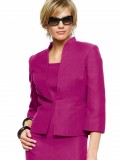Read this ebook for free! No credit card needed, absolutely nothing to pay.
Words: 28372 in 12 pages
This is an ebook sharing website. You can read the uploaded ebooks for free here. No credit cards needed, nothing to pay. If you want to own a digital copy of the ebook, or want to read offline with your favorite ebook-reader, then you can choose to buy and download the ebook.
In the upper square we find +4, enter this in upper square of second column at its full value as shown.
Next we find a "0" in the second square of first column, and as this is a loss of four seconds from the entry shown in the square above we carry it out in second column as -4. In the lower square of first column we find +16 and as this is a gain of sixteen seconds over the square above, it is necessary to carry this to second column at its full value as per illustration.
To determine the extent of variation between heat and cold, simply ignore the normal rate of -4 in the second column and subtract +4, from +16, which indicates an error of twelve seconds slow in heat compared to cold.
The rate in the normal period cannot be considered as of any value, its importance consisting only of allowing the metals to return to the natural form and tension before being placed in the cold box.
This is quite important in obtaining a true estimate of the error, because of the fact that in transferring the watch immediately from the extreme of heat to the extreme of cold, there will be a period of time during which the metals are readjusting themselves to the natural form, and the variation in time during this period will not be accounted for, as the real comparative rate will not begin to develop until after the natural form and tension is reached.
If the limit of time devoted to testing is no object and if a very fine rate is desired the observatory method is of course to be preferred. However, by allowing an intermediate day at normal temperature we have the assurance that the hairspring is at the same tension and that the balance has the same form concentrically when the test begins in cold that it had when the test began in heat.
As the object is to find the variation between the two temperature extremes the estimate will be quite close enough and allows the saving of many days' time. Some authorities advocate in addition to the five days required for observatory testing in each temperature that the watch be subjected to an intermediate day in each, instead of in normal, before considering the daily rate. This seems very logical, as the time noted each day would be taken at the actual extremes in both instances and any outside factor in the timing would be eliminated.
In making entries on the rate cards and in figuring the variations the sign + is used as denoting that the watch is running faster than the standard time and the sign - is used as denoting that it is running slower than standard time.
This is stated for the reason that in some instances, generally foreign, the signs are used in reverse, or as indicating that the watch requires a correction of + or - the number of seconds indicated, to attain the correct standard of time. When the signs are identical in a column it is necessary to subtract the lesser from the greater and the result is the variation. There are often instances however, when one rate will be + and the other - as shown in second column of Fig. 4, and in these instances it is necessary to add the figures to obtain the variation.
The first column is always the progressive rate and the second column shows the variation carried out. This example shows +8 in heat, the normal rate in the second square is not considered, for the reason previously explained and the rate in cold is shown as -1. The total variation between the extremes is therefore arrived at by adding +8 and -1, which in this instance gives us a total of nine seconds fast in heat.
Fig. 4
The extremes of 40? and 90? Fahr. have been used for the reason that they are best suited for general purposes. When it is known, however, that a watch is to be used in a warm climate the extremes may be raised five or ten degrees to advantage. If the watch is to be used in a cold climate, the extremes may be lowered this amount. The metals, however, can only stand the strain of expansion and contraction to a certain degree, and still maintain the positive qualities. Therefore it is quite important that the extremes be not raised or lowered very much beyond these figures.
Free books android app tbrJar TBR JAR Read Free books online gutenberg
More posts by @FreeBooks


: Notes and Queries Vol. IV Number 93 August 9 1851 A Medium of Inter-communication for Literary Men Artists Antiquaries Genealogists etc. by Various Bell George Editor - Questions and answers Periodicals Notes and Queries









